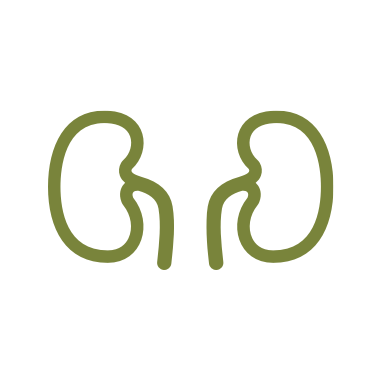
CLINICAL DATA
Research has been conducted into the use of Galafold in different patient populations; this is summarised below.

FACETS (Germain et al., 2016)
A randomised, double-blind, placebo-controlled trial in patients who were naïve to ERT or who had not received ERT for at least six months.
 FACETS study design
FACETS study design
67 patients were initially randomised into the study. After the start of the trial, the preliminary assay used to identify suitable patients was handed to a GLP-approved external laboratory and all the mutations were re-evaluated. Of the 67 initially randomised patients, only 50 met the amenability criteria when the GLP-assay was used. All the efficacy data are therefore based on the mITT, excluding the now non-amenable variants.1 The 50 patients aged 16–74 years with amenable mutations who were naïve to ERT or off ERT for ≥6 months were randomised to six months of Galafold or placebo, after which all patients received Galafold for the next six months followed by an optional 12-month OLE.2,3 Patients could then be enrolled in an additional OLE for continued Galafold treatment.3
 Study endpoints
Study endpoints
- Primary endpoint: percentage of patients with ≥50% reduction in KIC GL-3 inclusions from baseline to month six3
- Secondary objectives: to compare the effect of Galafold with that of placebo on urinary GL-3 levels, renal function, 24-hour urinary protein excretion, and safety and adverse events3
- Tertiary objectives: cardiac function, patient-reported outcomes, exploratory kidney analyses, and α-galactosidase activity in white cells3
 Reduction in disease substrates versus baseline
Reduction in disease substrates versus baseline
The primary endpoint (percentage of patients with ≥50% reduction in KIC GL-3 inclusions from baseline to month six) involving amenable and non-amenable patients did not reach significance. There were significant reductions in mean KIC GL-3 inclusions (a post hoc analysis of the mITT population) and in plasma lyso-Gb3.2,3 Significant reductions in GL-3 inclusion volume in podocytes were observed in a subset of eight male patients after six months of Galafold therapy in a retrospective study that used a highly sensitive quantitative analysis based on electron microscopy.4
 Stable renal function versus baseline
Stable renal function versus baseline
Renal function remained stable for up to five years in patients naïve to ERT. After an average of 3.4 years of treatment, the mean annualised rate of change in eGFRCKD-EPI was -0.74 mL/min/1.73 m2 (95% CI: -1.89, 0.40; n=41).2 No clinically significant differences in renal function were observed during the initial six month, placebo-controlled period.2
 Decreased LVMi versus baseline
Decreased LVMi versus baseline
Cardiac mass (as measured by LVMi was numerically reduced over a four-year period, with statistical significance achieved at 18 to 24 months. The mean change from baseline was -7.7 g/m2 (95% CI: -15.4, -0.01; n=27) at month 18 to 24, -8.3 g/m2 (95% CI: -17.1, 0.4; n=25) at month 36, and -9.1 g/m2 (95% CI: -20.3, 2.0; n=18) at month 48.2 Decreases in LVMi were greater in patients with LVH at baseline. No clinically significant differences in LVMi were observed during the initial six month, placebo-controlled period.2
 Adverse reactions
Adverse reactions
The most common adverse event listed in the Summary of Product Characteristics is headache (~10%).
In stage 1 of the study, adverse events with a higher frequency among those receiving Galafold than among those receiving placebo were headache (35% versus 21%) and nasopharyngitis (18% versus 6%). In stage 2 of the study, the most frequently reported adverse events were headache (14%), procedural pain (11%) and proteinuria (16%). During the OLE, the most frequently reported adverse events were headache (11%), and bronchitis (11%). Most adverse events were mild or moderate in severity.3
CI, confidence interval; eGFRCKD-EPI, estimated glomerular filtration rate—Chronic Kidney Disease Epidemiology Collaboration; ERT, enzyme replacement therapy; FACETS, Fabr AT1001 Chaperone Efficacy, Therapeutics, and Safety Study; GL-3, globotriaosylceramide; KIC, kidney interstitial capillary; LVH, left ventricular hypertrophy; LVMi, left ventricular mass index; lyso-Gb3, globotriaosylsphingosine; mITT, modified intent-to-treat; OLE, open-label extension.
ATTRACT (Hughes et al., 2017)
A randomised, open-label, active-controlled study in patients previously receiving ERT.2,5,6
 ATTRACT study design
ATTRACT study design
57 patients aged 16–74 years with amenable mutations who were receiving a stable dose of ERT were randomised (1.5:1) to switch to Galafold or continue on ERT for 18 months, after which all patients received Galafold for an additional 12 months.5
 Study endpoints
Study endpoints
- Co-primary endpoints: annualised changes in eGFRCKD-EPI and mGFRiohexol2,5
- Secondary endpoints included:5
- Annualised change in eGFRMDRD
- Composite clinical outcome assessment (the number of patients who experienced specified renal, cardiac or cerebrovascular events)
- Echocardiography measurements
- Patient-reported outcomes
- Plasma lyso-Gb3
 Stable renal function versus baseline
Stable renal function versus baseline
Renal function remained stable from baseline to month 18 in patients switched from agalsidase alfa (n=20) or agalsidase beta (n=11) to Galafold.6 Mean annualised rate of change in eGFRCKD-EPI was -0.40 mL/min/1.73 m2 (95% CI: -2.27, 1.48) with Galafold and -1.03 mL/min/1.73 m2 (95% CI: -3.64, 1.58) with continued ERT.2 Renal function remained stable over 30 months in the open-label extension.7 The co-primary endpoints met the criteria for comparability between Galafold and ERT.5
 Decreased LVMi versus baseline
Decreased LVMi versus baseline
LVMi decrease from baseline to month 18 was -6.6 g/m2 with Galafold (95% CI -11.0 to -2.2) and -2.0 g/m2 with ERT (95% CI -11.0 to 7.0) (Baseline: 95.3 g/m2 with Galafold and 92.9 g/m2 with ERT). Decreases in LVMi were greater in patients with LVH at baseline.5
 Clinical events
Clinical events
The composite clinical event rate from baseline to month 18 was 29% with Galafold and 44% with ERT.2 The frequency of events in patients treated with Galafold over 30 months was 32%.2
 Adverse reactions
Adverse reactions
The most common adverse event listed in the Summary of Product Characteristics is headache (~10%).
The most frequently reported treatment-emergent adverse events in the Galafold group were nasopharyngitis (33%) and headache (25%). These events had a comparable frequency in the ERT group (33% and 24% respectively). Most treatment-emergent adverse events were mild or moderate in severity.5
ATTRACT, AT1001 Therapy Compared to Enzyme Replacement in Fabry Patients with AT1001‑responsive Mutations: a Global Clinical Trial; CI, confidence interval; eGFRCKD-EPI, estimated glomerular filtration rate—Chronic Kidney Disease Epidemiology Collaboration; eGFRMDRD, estimated glomerular filtration rate using the Modification of Diet in Renal Disease; ERT, enzyme replacement therapy; LVH, left ventricular hypertrophy; LVMi, left ventricular mass index; lyso-Gb3, globotriaosylsphingosine; mGFRiohexol, measured glomerular filtration rate—iohexol.
HEK Assay Validation (Benjamin et al., 2017)
The validation of pharmacogenetics for the identification of Fabry patients to be treated with migalastat.1
 Study design
Study design
600 Fabry disease-causing mutations were expressed in HEK-293 cells and incubated in the presence or absence of 10 μmol/l migalastat to determine response. Mutant α-Gal A responses to migalastat in the GLP HEK assay were compared with the pharmacodynamic effects of oral migalastat on:1
- α-Gal A levels in peripheral blood mononuclear cells isolated from male Fabry patients
- Mean number of GL-3 inclusions per kidney interstitial capillary in male Fabry patients
- Plasma lyso-Gb3 in male and female Fabry patients
 Consistency of response
Consistency of response
Comparison of the GLP HEK assay results to in vivo white blood cell α-Gal A responses to migalastat in male patients showed high sensitivity, specificity, and positive and negative predictive values (≥0.875). GLP HEK assay results were also predictive of decreases in kidney GL-3 in males and plasma lyso-Gb3 in males and females.1
 Comparison of Phase II/III trial amenable mutations with all identified Fabry amenable mutations
Comparison of Phase II/III trial amenable mutations with all identified Fabry amenable mutations
The clinical study set of amenable mutations (n=51) was representative of all 268 amenable mutations identified by the GLP HEK assay. Mean absolute increase and relative increase over baseline of the 51 clinical trial-identified mutant forms (24.7±1.7 and 6.1±0.8 respectively) were comparable with the corresponding changes for all 268 amenable mutations (23.7±0.9 and 4.9±0.3 respectively).1
 Conclusion
Conclusion
The GLP HEK assay is a clinically validated method of identifying male and female Fabry patients who may be suitable for treatment with migalastat.1
α-Gal A, α-galactosidase A; GL-3, globotriaosylceramide; GLP, good laboratory practice; HEK cell, human embryonic kidney cell; lyso-Gb3, globotriaosylsphingosine.
Migalastat for Fabry disease in adolescents (Ramaswami et al., 2022)
A Phase IIIb, multicentre, uncontrolled, open-label, 1-year study in adolescent patients with Fabry disease weighing ≥45 kg.9
 Study Design
Study Design
21 patients aged 12 years to <18 years weighing ≥45 kg with confirmed Fabry disease and an amenable mutation received Galafold 123 mg every other day for 12 months.2,9
 Study endpoints
Study endpoints
The primary endpoints were safety and pharmacokinetics; other endpoints included change from baseline in eGFR, LVMi and plasma lyso-Gb3.2,9
 Pharmacokinetics
Pharmacokinetics
Exposure to Galafold in adolescent subjects was similar to adult exposures, based on AUCtau modelling.2
 Adverse reactions
Adverse reactions
The most frequent TEAE was upper respiratory tract infection.9 The majority of TEAEs were mild. None of the severe events were attributed to the study drug.10 The frequency, type and severity of adverse reactions are expected to be the same as in adults.2
AUCtau, area under the curve calculated to the end of the dosing interval; eGFR, estimated glomerular filtration rate; LVMi, left ventricular mass index; lyso-Gb3, globotriaosylsphingosine; TEAE, treatment-emergent adverse event.
Long-term follow-up of renal function (Bichet et al., 2021)
Long-term follow-up of renal function in patients treated with Galafold for Fabry disease, based on an integrated, post hoc analysis of long-term data from patients with amenable mutations in the Galafold Phase III trials and OLE.8
 Study design
Study design
A post hoc analysis of renal function was conducted in all patients with amenable mutations receiving Galafold for ≥2 years in the FACETS and ATTRACT clinical trials and OLE. Renal function was evaluated using eGFRCKD-EPI determined at baseline and every six months through to the completion of each study. The median duration of Galafold therapy across ERT-naïve and ERT-experienced patient populations exceeded five years.8
 Stable renal function versus baseline
Stable renal function versus baseline
Renal function remained generally stable across both groups. The mean annualised rate of change in eGFRCKD-EPI in patients treated with Galafold for ≥2 years was -1.6 for both ERT-naïve and ERT-experienced patients (analysis using simple linear regression). This effect was seen irrespective of phenotype.8
 Slower eGFR decline versus untreated cohorts
Slower eGFR decline versus untreated cohorts
Renal function remained generally stable across both groups. The mean annualised rate of change in eGFRCKD-EPI in patients treated with Galafold for ≥2 years was -1.6 for both ERT-naïve and ERT-experienced patients (analysis using simple linear regression). This effect was seen irrespective of phenotype.8
ATTRACT, AT1001 Therapy Compared to Enzyme Replacement in Fabry Patients with AT1001-responsive Mutations: a Global Clinical Trial; eGFRCKD-EPI, estimated glomerular filtration rate—Chronic Kidney Disease Epidemiology Collaboration; ERT, enzyme replacement therapy; FACETS, Fabr AT1001 Chaperone Efficacy, Therapeutics, and Safety Study; OLE, open-label extension.
Real-world data from the followME Pathfinders registry (Hughes et al., 2024)
Data from the followME Pathfinders registry, an ongoing patient-focused registry evaluating real-world safety, effectiveness, and patient-reported outcomes for current Fabry disease treatments, with a focus on patients receiving Galafold.
 Study Design
Study Design
The cohort of 125 patients in this analysis was made up of those who enrolled into followME and were aged ≥12 years, had eGFR ≥30 mL/min/1.73m2, and received no prior treatment or treatment for ≤2 years before enrolment.11
These patients received Galafold for a mean duration of 3.9 years. This includes retrospective data for 116 patients who started Galafold a mean 1.0 years before enrolments. 32 patients were switched from ERT to Galafold (29 patients before and three patients after enrolment). This analysis does not include patients from the registry who were treated with ERT or who received no treatment.11
 Outcome analysis
Outcome analysis
Outcomes included the occurrence of SAEs, FACEs and measurement of renal function.11
FACE definitions11
| Definitions | |
| Cardiac |
|
| Cerebrovascular |
|
| Renal |
|
| Death |
|
 Patient population
Patient population
The followME Galafold cohort included patients with clinically significant disease:11
- 64% of males (n=75) and 56% of females (n=50) had multiorgan disease at enrolment.
- In patients with available LVMi data, 65% of males (n=34) and 59% of females (n=27) had LVH at enrolment.
- Approximately two thirds of patients had CKD stage 2 or 3 at enrolment (n=122).
- 82% of patients were aged >40 years, a population older than in previous clinical trials and real-world evidence studies of Galafold and ERT.
 Preservation of renal function
Preservation of renal function
Annualised rate of change in eGFR was stable over a mean 3.9 years of Galafold treatment regardless of renal function at enrolment:11
- Mean annualised rate of change in eGFRCKD-EPI -1.0 in CKD class 1 (eGFR ≥90 mL/min/1.73m2)
- Mean annualised rate of change in eGFRCKD-EPI -1.0 in CKD class 2 (eGFR ≥60–90 mL/min/1.73m2)
- Mean annualised rate of change in eGFRCKD-EPI -0.4 in CKD class 3 (eGFR ≥30–60 mL/min/1.73m2)
eGFR was stable across all eGFR categories, suggesting preservation of renal function while on Galafold treatment, regardless of renal involvement at enrolment. The observed rate of change in eGFR is in line with therapeutic goals for maintenance of renal function, consistent with age-related decline, and is comparable with data reported from real-world studies of ERT.11
 FACEs
FACEs
This study counted all reported clinical events, whether a patient experienced a single FACE or multiple FACEs, rather than only the first event as in other studies of Fabry disease.11
80% of patients did not experience a FACE during the mean 3.9 years of Galafold treatment. There were no stroke events during the analysis period, despite stroke being 12 times more common in patients with Fabry disease than in the general population.11
The incidence of cardiac events in this real-world study is numerically higher than in long-term follow-up of the Phase III Galafold trials. This could be explained by the older age of this study population in which events could have been overattributed to Fabry disease, along with LVMi and more advanced disease at enrolment.11 These data are suggestive of a population with a heightened risk of cardiac complications and align with the natural history of Fabry disease in which FACE incidence increases with organ damage and age. Furthermore, 30% of patients had the N215S mutation, which has been associated with cardiac pathology and late-onset cardiac manifestations.11
Occurrence of FACEs during Galafold treatment (N=215)11
| FACE category | FACE incidence, n (%) | Incidence per 1000 patient-years |
| Composite | 25 (20.0) | 89.3 |
| Cardiac | 24 (19.2) | 83.2 |
| Cerebrovascular | 2 (1.6) | 4.1 |
| Renal | 1 (0.8) | 2.0 |
 SAEs
SAEs
84% of patients had no SAEs during the mean treatment period of 3.9 years. One SAE was deemed possibly related to Galafold (a transient ischaemic attack), with others unlikely or unrelated.11
CKD, chronic kidney disease; eGFR, estimated glomerular filtration rate; eGFRCKD-EPI, estimated glomerular filtration rate—Chronic Kidney Disease Epidemiology Collaboration; ERT, enzyme replacement therapy; FACE, Fabry-associated clinical event; LVH, left ventricular hypertrophy; LVMi, left ventricular mass index; SAE, serious adverse event.
If you would like to learn more about this clinical data then please contact your local Amicus representative.
References
- Benjamin ER, Della Valle MC, Wu X, et al. The validation of pharmacogenetics for the identification of Fabry patients to be treated with migalastat. Genet Med. 2017;19(4):430-438.
- Summary of product characteristics. Galafold 123 mg hard capsule. Amicus Therapeutics Ltd. Available at: https://www.medicines.org.uk/emc/product/10934/smpc
- Germain DP, Hughes DA, Nicholls K, et al. Treatment of Fabry’s disease with the pharmacologic chaperone migalastat. N Engl J Med. 2016;375(6):545-555.
- Mauer M, Sokolovskiy A, Barth JA, et al. Reduction of podocyte globotriaosylceramide content in adult male patients with Fabry disease with amenable GLA mutations following 6 months of migalastat treatment. J Med Genet. 2017;54(11):781-786.
- Hughes DA, Nicholls K, Shankar SP, et al. Oral pharmacological chaperone migalastat compared with enzyme replacement therapy in Fabry disease: 18-month results from the randomized phase III ATTRACT study. J Med Genet. 2017;54(4):288-296.
- Sunder-Plassmann G, Jovanovic A, Feldt-Rasmussen U, et al. Clinical outcomes after switching to migalastat from agalsidase alfa or agalsidase beta in patients with Fabry disease: post hoc analysis from ATTRACT. Presented at the 15th Annual WORLDSymposium. Orlando, FL; February 4-8, 2019.
- Feldt-Rasmussen U, Hughes D, Sunder-Plassmann G, et al. Oral pharmacological chaperone migalastat compared with enzyme replacement therapy in Fabry disease: 30-month results from the randomized phase 3 ATTRACT study. Presented at the 15th Annual WORLD Symposium. Orlando, FL; February 4-8, 2019.
- Bichet DG, Torra R, Wallace E, et al. Long-term follow-up of renal function in patients treated with migalastat for Fabry disease. Mol Genet Metab Rep. 2021;28:100786.
- Ramaswami U, Wilcox W, Hopkin RJ, Yang H, Jiang H, Lengoc V. Migalastat HCl 150 mg every other day is well tolerated and efficacious in adolescent patients with Fabry disease. Presented at the 18th Annual WORLDSymposium™; February 7-11, 2022; San Diego, CA.
- Data on file, Amicus Therapeutics. Study AT1001-020.
- Hughes DA, Sunder-Plassmann G, Jovanovic A, et al. Renal and multisystem effectiveness of 3.9 years of migalastat in a global real-world cohort: results from the followME Fabry Pathfinders registry. J Inherit Metab Dis. 2024;1-14. doi:10.1002/jimd.12771. Online ahead of print.
